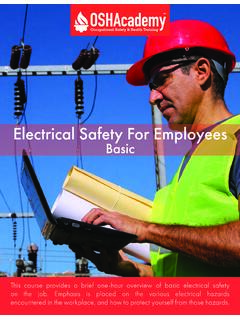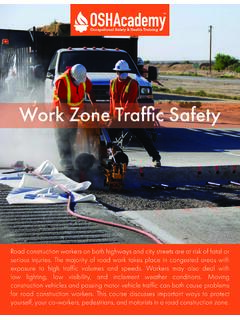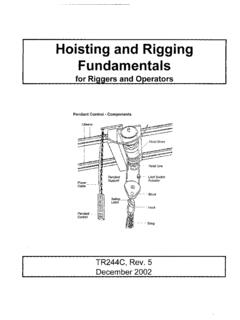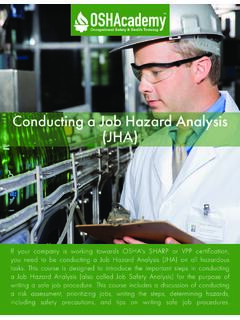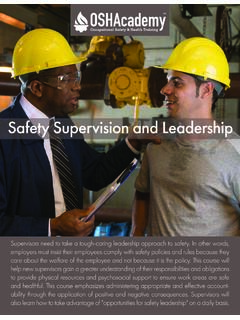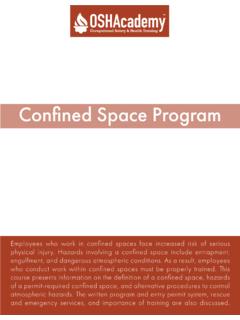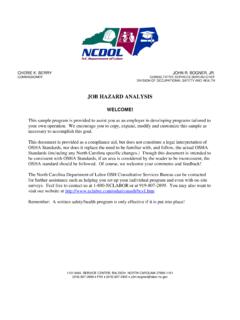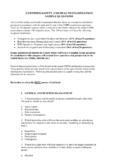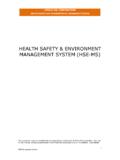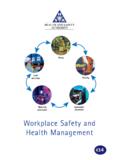Transcription of (Sample) Safety and Health Training Plan - OSHA …
1 (Sample) Safety and Health Training plan Introduction Training is one of the most important components within our company s Safety management system. It gives employees an opportunity to learn their jobs properly, bring new ideas into the workplace, reinforce existing ideas and practices, and it helps to put our Safety and Health Program into action. Everyone in our company will benefit from Safety and Health Training through fewer workplace injuries and illnesses, reduced stress, and higher morale. Productivity, profits, and competitiveness will increase as production costs per unit, turnover, and workers compensation rates lower.
2 Management commitment. We (or company name) will provide the necessary funds and scheduling time to ensure effective Safety and Health Training is provided. This commitment will include paid work time for Training and Training in the language that the worker understands. Both management and employees will be involved in developing the program. To most effectively carry out their Safety responsibilities, all employees must understand (1) their role in the program, (2) the hazards and potential hazards that need to be prevented or controlled, and (3) the ways to protect themselves and others.
3 We will achieve these goals by: educating everyone on the natural and system consequences of their actions; educating all managers, supervisors and employees on their Safety management system responsibilities; educating all employees about the specific hazards and control measures in their workplace; Training all employees on hazard identification, analysis, reporting and control procedures; and Training all employees on safe work procedures and practices. Our Training program will focus on Health and Safety concerns that determine the best way to deal with a particular hazard.
4 When a hazard is identified, we will first try to remove it entirely. If that is not feasible, we will then train workers to protect themselves, if necessary, against the remaining hazard. Once we have decided that a Safety or Health problem can best be addressed by Training (or by another method combined with Training ), we will follow up by developing specific Training goals based on those particular needs. Employees. At a minimum, employees must know the general Safety and Health rules of the worksite, specific site hazards and the safe work practices needed to help control exposure, and the individual's role in all types of emergency situations.
5 We will ensure all employees understand the hazards to which they may be exposed and how to prevent harm to themselves and others from exposure to these hazards. We will commit available resources to ensure employees receive Safety and Health Training during the circumstances below. Whenever a person is hired --general Safety orientation including an overview of company Safety rules, and why those rules must be followed. Whenever an employee is given a new job assignment --during formal classroom Training , and again, when the supervisor provides specific task Training .
6 It s extremely important that supervisors emphasize Safety during initial task assignment. Whenever new work procedures are begun --during formal classroom Training and supervisor on-the-job Training . Whenever new equipment is installed --if new hazards are introduced. Whenever new substances are used --hazard communication program may apply. The bottom line --train Safety whenever a new hazard is introduced to the employee. Employees must know they are responsible for complying with all company Safety rules, and that most accidents will be prevented by their safe work practices.
7 They must be very familiar with any personal protective equipment required for their jobs. They must know what to do in case of emergencies. Each employee needs to understand that they are not expected to start working a new assignment until they have been properly trained. If a job appears to be unsafe, they will report the situation to their supervisor. Supervisors. Supervisors will be given special Training to help them in their leadership role. They will be taught to look for hidden hazards in the work under their supervision; insist on the maintenance of the physical protection in their areas; and reinforce employee hazard Training through performance feedback and consistent enforcement when necessary.
8 We will commit necessary resources to ensure supervisors understand the responsibilities below and the reasons for them: Detecting and correcting hazards in their work areas before they result in injuries or illnesses Providing physical resources and psychosocial support that promote safe work Providing performance feedback and effective recognition and discipline techniques Conducting on-the-job Training Supervisors are considered the primary Safety trainers. All supervisors will complete train-the-trainer classes to learn Training techniques and how to test employee knowledge and skills.
9 They will also receive Training on how to apply fair and consistent recognition and discipline. Supervisor Training may be provided by the supervisor's immediate manager, by the Safety Department, or by outside resources. Managers. All line managers must understand their responsibilities within our Safety and Health Program. This may require classroom Training and other forms of communication. Formal classroom Training may not be necessary. The subject can be covered periodically as a part of regular management meetings. Managers will be trained in the following subject areas: the elements of the Safety management system, and the positive impact the various processes within the system can have on corporate objectives; their responsibility to communicate the Safety and Health Program goals and objectives to their employees; their role that includes making clear assignments of Safety and Health Program responsibilities, providing authority and resources to carry out assigned tasks, and holding subordinate managers and supervisors accountable.
10 And actively requiring compliance with mandatory Safety and Health Program policies and rules and encouraging employee involvement in discretionary Safety activities such as making suggestions and participation in the Safety committee. Training will emphasize the importance of managers' visibly showing their commitment to the Safety and Health program. They will be expected to set a good example by scrupulously following all the Safety and Health rules themselves. Incentives, Recognition and Reward The purpose of an effective incentive/recognition process is to motivate employee involvement and build ownership in our Safety culture.

